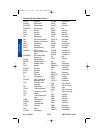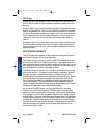
C-1
Rev 2 Apr/2004 KMD 250 Pilot's Guide
Appendix C
GPS Primer
APPENDIX C
GPS PRIMER
BACKGROUND
The Global Positioning System (GPS) is a satellite-based navigation
system that was originally conceived and implemented by the United
States Department of Defense (DoD). The system is, however, available
to all civilian users free of charge. GPS provides extremely precise posi-
tion, velocity, and time information.
The satellites are not geosynchronous, as is the case with many weather
and television satellites. That is, each satellite is not above a fixed spot
on the Earth all the time, but rather is continuously moving across the
sky. In fact, each satellite completely orbits the Earth two times per day.
The Department of Defense has the capability to impose an intentional
accuracy degradation of the GPS system. This degradation is known as
Selective Availability (SA). When SA is active, only U.S. military users
have access to full GPS accuracy. For civilian users, position accuracy
is degraded to no worse than 100 meters 95% of the time. At the time of
this writing, Selective Availability has been turned off by the DOD but it
could be turned back on at another time .
GPS POSITION DETERMINING CONCEPT
The technique used to determine position is fundamentally very simple.
The complicated part is accounting for and correcting all the possible
errors in the position.
The GPS receiver is able to determine the time it takes a radio signal to
travel from the satellite to the GPS antenna. Since this radio signal
travels at the speed of light (approximately 186,000 statute miles per
second), the time delay can very easily be used to determine the
receiver’s distance from a given satellite. If measurements are taken
from four satellites (or three satellites and an input from an aircraft
altimeter), the receiver can identify its position very precisely.
For example, the GPS receiver might determine that it is exactly 12,000
miles from satellite A, 12,700 miles from satellite B, and 13,100 miles
from satellite C. At the same time, the aircraft’s encoding altimeter might
be indicating an altitude of 9,500 feet MSL. There is only one point in
space that satisfies these four measurements.
GPS DATA SIGNALS
Two of the primary types of signals that the GPS satellites broadcast are
almanac and ephemeris data. These signals enable the GPS receiver to
GPS Primer
Appendix C 8/13/07 10:02 AM Page C-1


















